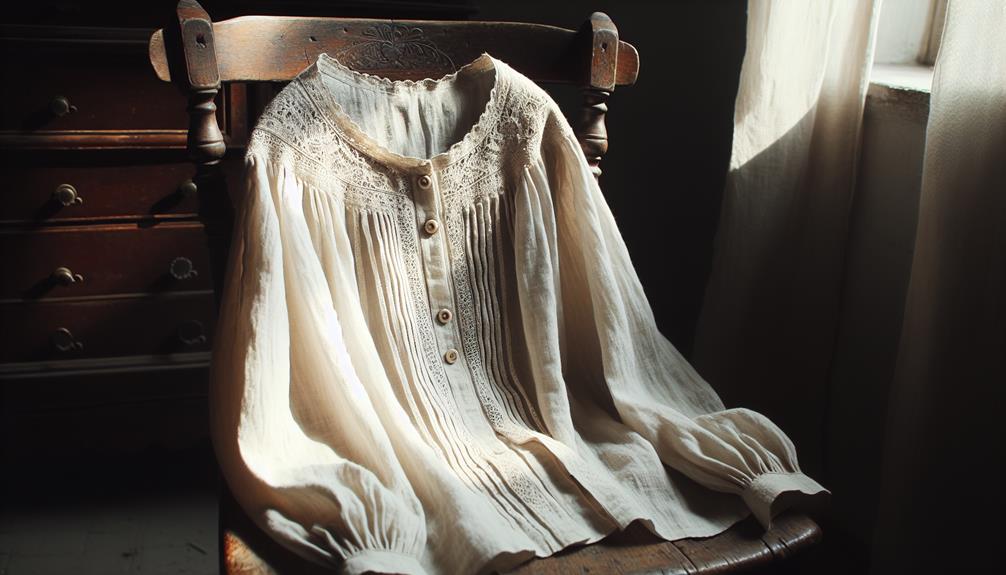I've always been fascinated by how long linen fabric can last. We all know it's tough, but the real magic lies in its care and the daily choices we make. From the thickness of the fibers to our washing habits, there's a lot that goes into keeping linen looking its best. I've noticed that with a bit of know-how, these pieces can outlive many other fabrics in our closets and homes. It's not just about durability; it's about the stories and memories these linen items hold over years. So, let's dive into what makes linen stand the test of time and how we can make our favorite pieces last even longer. Who knows what tips and tricks we might uncover together?
Table of Contents
Key Takeaways
- Linen fabric can last for several decades with proper care and maintenance.
- The longevity of linen is enhanced by avoiding bleach, using lukewarm water, and air drying.
- Thicker linen fibers contribute to greater durability and a longer lifespan.
- Regular gentle washing without fabric softeners preserves linen's strength and softness over time.
- Vintage linen often showcases superior longevity, becoming softer and more cherished with age.
Understanding Linen Durability
Though it might surprise some, linen's durability is a key reason it's been a favorite for generations. We're not just talking about any fabric here; we're diving into what makes linen stand the test of time. Let me break it down for you. Linen, with its reputation for exceptional strength and longevity, isn't just about looking good. This fabric is a workhorse.
Now, if you're eyeing that vintage linen, you're on the right track. Its desirability isn't just in its aesthetic but in its ability to last decades with the right TLC. Here's the scoop: thicker linen fibers boast more durability but might give you that rough feel at first touch. On the flip side, fine linen feels like a dream from the get-go but mightn't hold up as well in the marathon of life.
But here's where it gets real – the secret sauce to linen's longevity is proper care. I'm talking about washing habits that steer clear of harsh chemicals and embracing the air-dry life. Trust me, it's like giving your linen a personal spa day; it extends its lifespan, making sure it stays in your wardrobe rotation for years to come.
The Aging Process of Linen
After exploring how to care for linen, let's now look at how it ages over time. It's fascinating to see how this fabric made to last, actually transforms. Linen's aging process isn't just about it getting older; it's about it getting better. I've seen linen pieces passed down in European families, becoming softer and more cherished with each generation. This isn't your typical wear and tear—it's a journey to peak coziness.
Here's a quick snapshot of how linen evolves:
| Age | Texture | Appeal |
|---|---|---|
| New | Crisp | Clean |
| 1-2 Years | Slightly Softened | Comfortably Familiar |
| 3-5 Years | Noticeably Softer | Increasingly Desirable |
| 5-10 Years | Very Soft | Deeply Valued |
| 10+ Years | Ultra Soft | Vintage Treasure |
This table shows the beauty of the aging process. Each stage brings its own joy, moving from that fresh, crisp feeling to an ultra-soft texture that makes vintage linen so sought after. It's a testament to the quality and enduring appeal of linen. With proper care, we're not just preserving fabric; we're nurturing a legacy. That's the magic of linen—it doesn't just age; it matures beautifully.
Proper Linen Care Techniques
Understanding the right way to care for linen can significantly extend its life, making it a key aspect of owning this timeless fabric. I've found that steering clear of bleach and fabric softeners when I wash linen is crucial. These harsh chemicals can really do a number on the fabric, making it brittle and less durable over time. Instead, I stick to lukewarm water. It's gentle on the linen fibers, ensuring they don't get damaged and helping my linen items last longer.
I always make it a point to wash my linen separately. This way, I avoid any snagging or tearing that might happen if it gets mixed up with other items. Trust me, it's a game-changer. And when it comes to drying, I've ditched the tumble dryer. Air drying is the way to go. It might take a bit longer, but it's worth it to protect the integrity of the fabric.
Adopting these proper washing habits has really made a difference in how long my linen bedding lasts. It's all about treating the fabric with the care it deserves, ensuring that these pieces can be enjoyed for years to come.
Signs of Linen Wear and Tear
Despite our best efforts to care for linen, it inevitably begins to show signs of wear and tear over time. Even my favorite linen bedding isn't immune to the ravages of regular use and washing. So, what're the red flags I look out for? Let me break it down:
- Thinning Fabric and Fraying Edges: The first thing I notice is how the fabric feels thinner in places that get the most use, like the middle of the bedsheet. The edges start to fray, too, signaling it's been through a lot.
- Fading Colors and Rough Texture: My once vibrant linen starts to lose its color, and the sheen that made it so appealing. The texture also gets rougher, which is a clear sign the fibers are breaking down.
- Pilling, Snags, and Unraveling Threads: These annoyances are telltale signs. When my linen starts to pill or I spot snags and loose threads, I know it's nearing the end of its lifespan.
- Stains and Yellowing: Try as I might to keep it pristine, stains and a gradual yellowing indicate the linen is aging. It's disheartening to see, especially on lighter shades.
Each of these signs tells me it's time to start thinking about a replacement. Despite this, I try to extend its life as much as possible, because good linen bedding isn't just fabric; it's an investment in my comfort.
Comparing Linen With Other Fabrics
When comparing linen to other fabrics like cotton, its superior strength and moisture absorbency really stand out. You're looking for fabric that'll last, right? Well, linen's your guy. It's not just about lasting longer; it's about providing that cool, airy feel on a hot summer night without wearing thin after a few washes. And if you're someone who snoozes better knowing their sheets are eco-friendly, linen's less thirsty nature in production is a big win.
But let's break it down a bit:
| Feature | Linen | Cotton |
|---|---|---|
| Durability | High | Moderate |
| Moisture Absorbency | Excellent | Good |
| Hypoallergenic | Yes | Less so |
Linen's durability is a game-changer. We're talking decades of use with proper care. And for those with sensitive skin, its hypoallergenic properties are a relief. Plus, cotton sheets might feel soft, but they don't offer the same breathability or moisture-wicking capabilities. Sure, cotton's the familiar choice, but if you're after longevity and comfort, linen's the way to go. Trust me, it's worth the switch.
The Lifespan of Linen Bedding
When I think about the longevity of linen bedding, I'm struck by how its lifespan is influenced by various factors, including how we care for it and the quality of the linen itself. I've learned that not all linen is created equal; the thicker fibers and higher quality linen can seriously extend its life.
Now, let's talk about what makes linen bedding last so long, how to keep it in top shape, and the signs it's aging.
Durability Factors
Understanding the durability of linen bedding starts with knowing it's made from the flax plant's bast, which naturally enhances its toughness. When we dive into durability factors, a few key points stand out:
- Flax Plant Origin: The bast of the flax plant gifts linen its durability.
- Fiber Thickness: Harvesting time affects this, influencing longevity. Thicker fibers mean more durability but a rougher initial feel.
- Initial Feel vs. Durability: Finer, softer linen mightn't last as long.
- Proper Care: How you wash and care for your linen can significantly impact its lifespan.
Mastering these aspects ensures your linen bedding remains a long-term comfort and style investment. Remember, it's all about striking the balance between care and natural attributes.
Maintenance Tips
Let's dive into how you can keep your linen bedding in top shape for years with some smart maintenance tips.
First off, ditch the bleach and say no to hot washes. Linen sheets thrive in cooler temperatures and gentle washing cycles. It's a game-changer, especially for people with sensitive skin, as it preserves the fabric's softness and durability.
Always wash your linen separately. Trust me, avoiding snags and tears from other items can significantly extend their lifespan. And when it's drying time, let them air dry. Tumble dryers? Not the best pals for your linen.
This approach not only saves you from having to replace sheets often but ensures your linen bedding remains a cozy, quality haven for years.
Aging Signs
After covering how to maintain your linen bedding, it's worth noting the signs that indicate it's aging. Despite its durability, even quality linen shows wear and tear over time. Here's what to look out for:
- Thinning fabric, which means it's losing its strength.
- Color fading, a clear sign that the sun or washing has taken its toll.
- Rough texture, suggesting that the softness has been compromised.
- Frequent snags or tears, indicating it might need to be replaced soon.
Factors Affecting Linen Longevity
Several factors, from the thickness of its fibers to how we wash and care for it, play a crucial role in determining how long linen lasts. Let's dive into the nitty-gritty, shall we? I've learned that not all linen is created equal. The thickness of those linen fibers? Yeah, it matters—a lot. Thicker fibers mean we're in for the long haul, while thinner ones might not see as many sunrises.
Now, check this out:
| Factor | Impact on Linen Longevity |
|---|---|
| Fiber Thickness | More thickness = more durability |
| Washing Habits | Proper care extends life |
| Vintage vs. Modern | Vintage linen lasts longer |
| Wear Frequency | Less wear, longer life |
Vintage linen, like that Fil de Lin stuff from way back when, is on another level of tough. But, here's the kicker: our modern linen might not be hitting the same marks because we've switched up the thread game.
And here's where it gets really interesting. How we wash and look after our linen fabric seriously impacts its lifespan. Too harsh, and we're basically waving goodbye to our beloved sheets. So, yeah, wear and wash wisely. It's all about that tender loving care.
Enhancing Linen's Life Cycle
By giving our linen the TLC it deserves, we can significantly boost its lifespan. Whether it's those cozy bed sheets or the European linen tablecloth passed down through generations, how they're washed and cared for plays a huge role.
Here's how I make sure my linen stays in tip-top shape:
- Gentle Washing: I always opt for a gentle wash cycle with a mild detergent. Linen's not a fan of harsh chemicals, and treating it gently ensures it doesn't get prematurely worn out.
- Avoid High Heat: I learned the hard way that linen and high heat don't mix. Now, I air-dry my linen items or use a low heat setting if I'm in a rush. This keeps them from losing their shape or becoming brittle.
- Rotate Regularly: Just like tires, linen benefits from being rotated. I make it a point to switch up my bed sheets and other linen items regularly, so they wear evenly. This little trick has added years to their life.
- Invest in Quality: Lastly, I don't skimp on quality. Investing in high-quality European linen might seem steep initially, but it pays off. Better durability means I'm not replacing items as often, making it worth every penny.
Linen Storage Best Practices
Now, let's talk about keeping your linen in tip-top shape with some storage tips.
I've found that mastering proper folding techniques and understanding the ideal conditions for storing linen can make a huge difference.
These steps ensure your linen stays fresh and lasts longer, so let's get into the specifics.
Proper Folding Techniques
To keep your linen in top shape, it's crucial to master the right way to fold it, steering clear of those sharp creases that can break the fibers. When it comes to sheets and bedding, ensuring they last isn't just about how you wash them but also how you store them.
Here's how I do it:
- Fold along natural lines and curves: This keeps the integrity of the material intact.
- Use acid-free tissue paper: Placing it between layers reduces friction and damage.
- Avoid plastic bags: They suffocate linen, preventing it from breathing.
- Embrace the soft fold: Sharp creases are the enemy; a gentle fold is your friend.
Ideal Storage Conditions
Ensuring your linen lasts longer isn't just about how you fold it; where and how you store it plays a crucial role too. Keeping your linen fabrics in the right conditions means you're not replacing your bedding anytime soon. Here's the deal:
| Do's | Don'ts |
|---|---|
| Store in a cool, dry place | Avoid direct sunlight |
| Use breathable fabric bags | Don't use plastic bags or containers |
| Keep it flat and uncramped | Don't overcrowd |
Sticking to these pointers ensures your bedding lasts, reducing the frequency of updating your linen closet. It's about giving those linen fabrics the TLC they need to stay fresh and fabulous. Remember, it's not just about saving money; it's about preserving quality and comfort too.
When to Replace Linen Items
Knowing when it's time to swap out your linen items can save you from discomfort and maintain your home's hygiene. It's not just about keeping things fresh; it's about understanding the signs that your linens are begging for retirement. Here's my go-to checklist:
- Fitted Sheets and Body Oils: These guys are workhorses, but they don't last forever. Despite regular washing, body oils can build up, leading to yellowing and fabric breakdown. I aim to replace mine every two years to keep my sleep zone in top shape.
- Visible Wear and Tear: If I spot holes, tears, or any form of disintegration, I don't hesitate. It's out with the old. This isn't just about looks; it's about function and comfort too.
- Loss of Loveliness: When my linen loses its volume, stiffness, or that cozy softness, I take it as a sign. It's no longer serving its purpose if it can't provide the comfort it once did.
- Allergic Reactions or Discomfort: The moment I start sneezing or itching, I know something's off. Linens that trigger allergic reactions or cause skin irritation have no place in my sanctuary.
Staying on top of these signs ensures my linen collection remains functional, comfortable, and, most importantly, hygienic.
Preserving Vintage Linen Treasures
Now, let's talk about keeping those vintage linen pieces looking great.
I'll show you how to store, clean, and fix up any damage to make sure they last even longer.
It's all about giving those beautiful textiles the care they deserve.
Proper Storage Methods
To keep your vintage linen treasures in top shape, it's crucial to store them right, steering clear of sunlight and moisture. After all, nobody wants their favorite top sheet losing that crisp linen feels because it wasn't cared for properly. Besides, we all know linen doesn't need to be washed as often as other fabrics, so proper storage is key to longevity.
Here's how I do it:
- Avoid Sunlight: I keep them out of direct sunlight to prevent yellowing.
- Cool, Dry Places: I stash my linens in spots with good air circulation.
- Wrap 'Em Up: I use acid-free tissue or muslin cloth for wrapping.
- No Plastic Bags: I never store them in plastic to avoid trapping moisture.
Rotating them occasionally keeps creases from becoming permanent. Simple, right?
Cleaning Vintage Linen
When it comes to cleaning vintage linen, the right approach can make all the difference in preserving those precious heirlooms. Vintage linen, especially Fil de Lin from the mid-19th century, is known for its exceptional strength and durability, thanks to the cabled yarn and thicker threads. However, modern linen might not hold up as well due to changes in thread thickness. So, cleaning these treasures requires a bit of know-how.
| Do | Don't |
|---|---|
| Use mild, pH-neutral soap | Bleach or use harsh chemicals |
| Hand wash gently | Machine wash |
| Dry flat away from direct sun | Tumble dry |
| Iron while damp | Iron on high heat |
| Store properly after cleaning | Store in plastic bags |
Repairing Damaged Linen
Repairing damaged linen, a task that may seem daunting at first, involves delicate stitching to carefully mend any tears or holes, ensuring those vintage treasures last for many more years. Here's how I tackle it:
- Handwash and air dry before any repairs to ensure I'm working with clean fabric.
- Use delicate stitching techniques for mending, matching the thread as closely as possible to the original fabric.
- Seek professional restoration for those pieces that are too valuable or fragile for amateur hands.
- Avoid harsh chemicals at all costs, whether cleaning or repairing, to preserve the integrity of the linen.
Storing in acid-free tissue paper is my go-to for keeping them in pristine condition. It's all about loving and preserving those vintage linen gems for the future.
Frequently Asked Questions
How Many Years Can Linen Last?
I've learned that linen can last for decades if you take good care of it. High-quality linen pieces often stay strong for over 20 years, even lasting generations, which beats cotton or polyester.
Does Linen Wear Out?
I've discovered that linen doesn't really wear out quickly. It actually gets softer and nicer with each wash. Given its strong fibers, linen's super durable, outlasting other fabrics and becoming comfier over time.
Does Linen Last Longer Than Cotton?
I've found that linen definitely outlasts cotton. Its thicker fibers mean it can endure more washes and wear, getting softer without losing quality. So, yes, linen lasts longer, making it a smart choice.
How Often Do You Need to Replace Linens?
I typically replace my linens every few years, but high-quality linen can last up to 20 if cared for properly. It's all about regular washing and avoiding harsh handling to extend their life.
- How to Properly Clean and Maintain Nonwoven Products - July 11, 2025
- A Deep Dive Into Spunbond vs. Spunlace Nonwovens - July 11, 2025
- Nonwoven Wallpaper: Pros, Cons, and Installation Tips - July 11, 2025






